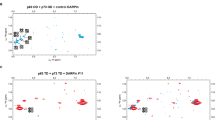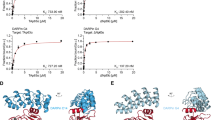Abstract
p18INK4c is a member of a family of INK4 proteins that function to arrest the G1 to S cell cycle transition by inhibiting the activity of the cyclin-dependent kinases 4 and 6. The X-ray crystal structure of the human p18INK4c protein to a resolution of 1.95 Å reveals an elongated molecule comprised of five contiguous 32- or 33-residue ankyrin-like repeat units. Each ankyrin-like repeat contains a β-strand helix-turn-helix extended strand β-strand motif that associates with neighboring motifs through β-sheet, and helical bundle interactions. Conserved ankyrin-like repeat residues function to facilitate the ankyrin repeat fold and the tertiary interactions between neighboring repeat units. A large percentage of residues that are conserved among INK4 proteins and that map to positions of tumor-derived p16INK4 mutations play important roles in protein stability. A subset of these residues suggest an INK4 binding surface for the cyclin-dependent kinases 4 and 6. This surface is centered around a region that shows structural features uncharacteristic of ankyrin-like repeat units.
This is a preview of subscription content, access via your institution
Access options
Subscribe to this journal
Receive 12 print issues and online access
$189.00 per year
only $15.75 per issue
Buy this article
- Purchase on Springer Link
- Instant access to full article PDF
Prices may be subject to local taxes which are calculated during checkout
Similar content being viewed by others
References
Morgan, D.O. Principles of CDK regulation. Nature 374, 131–134 (1995).
Elledge, S.J. & Harper, J.W. Cdk inhibitors: on the threshold of checkpoints and development. Curr. Opin. Cell Biol. 6, 847–852 (1994).
Hollingsworth, R.E., Phang-Lang, J. & Lee, W.-H. Integration of cell cycle control with transcriptional regulation by the retinoblastoma protein. Curr. Opin. Cell Biol. 5, 194–200 (1993).
Weinberg, R.A. The retinoblastoma protein and cell cycle control. Cell 81, 323–330 (1995).
Chow, K.N.B., Starostik, P. & Dean, D.C., The Rb family contains a conserved cyclin-dependent-kinase-regulated transcriptional represser motif. Mol. Cell. Biol. 16, 7173–7181 (1996).
Ranade, K. et al Mutations associated with familial melanoma impair p16INK4 function. Nature Genet. 10, 114–116 (1995).
Serrano, M., Hannon, G.J. & Beach, D. A new regulatory motif in cell cycle control causing specific inhibition of cyclin D/CDK4. Nature 366, 704–707 (1993).
Kamb, A., et al. A cell cycle regulator potentially involved in the genesis of many tumor types. Science 264, 436–440 (1994).
Hannon, G.J. & Beach, D. p15INK4B is a potential effector of TGF-—induced cell cycle arrest. Nature 371, 257–261 (1994).
Guan, K.-L. et al Growth by suppression by p18, a P16INK4/MTS1- and P14INK4B/MTS2-related CDK6 inhibitor, correlates with wild-type pRb function. Genes Dev. 8, 2939–2952(1994).
Chan, F.K.M., Zhang, J., Cheng, L., Shapiro, D.N. & Winoto, A. Identification of human and mouse p19, a novel CDK4 and CDK6 inhibitor with homology to p16ink4. Mol. Cell. Biol. 15, 2682–2688 (1995).
Ragione, F.D., Borriello, A.,, L. & Iolascon, A. Cell division cycle alterations in human malignancies Cancer J. 10, 151–156 (1997).
Pollock, P.M., Pearson, J.V. & Hayward, N.K. Compilation of somatic mutations of the CDKN2 gene in human cancers: non-random distribution of base substitutions. Genes Chromosom. Cancer 15, 77–88 (1996).
Smith-Sorensen, B. & Hovig, E. CDK2A (p16INK4A) somatic and germline mutations.Human Mutation 7, 294–303 (1996).
Miller, C.W. . et al. The p19INK4D cyclin dependent kinase inhibitor gene is altered in osteosarcoma. Oncogene 15, 231–235 (1997).
Gemma, A., et al. Molecular analysis of the cyclin-dependent kinase inhibitor genes 15INK4b/MTS2, pINK4/MTS1, p18 and p18 in human cancer cell lines. Int. J. Cancer 68, 605–611 (1996).
Lux, S., John, K. & Bennett, V. Analysis of cDNA for human erythrocyte ankyrin indicates a repeated structure with homology to tissue-differentiation and cell-cycle control proteins. Nature 344, 36–42 (1990).
Michaely, P. & Bennett, V. The ANK repeat: a ubiquitous motif involved in macromolecular recognition. Trends Cell. Biol. 2, 127–130 (1992).
Bork, P. Hundreds of ankyrin-like repeats in functionally diverse proteins: mobile modules that cross phyla horizontally? Proteins 17, 363–374 (1993).
Pabo, C.O. & Sauer, R.T. Transcription factors: structural families and principles of DNA recognition. Annu. Rev. Biochem. 61, 1053–1095 (1992).
Pines, J. Cyclins and cyclin-dependent kinases: theme and variations. Adv. Cancer Res. 66, 181–212 (1995).
Luh, F.Y. et al. Structure of the cyclin-dependent kinase inhibitor p19lnk4d. Nature 389, 999–1003 (1997).
Svetlana, G. & Pavletich, N.P. Structure of the p53 tumor suppressor bound to the ankyrin and SH3 domains of p53BP2. Science 274, 1001–1005 (1996).
Tevelev, A., et al. Tumor suppressor p16INK4: structural charcterization of wild-type and mutant proteins by NMR and circular dichroism. Biochemistry 35, 9475–9487 (1996).
Kalus, W., et al. NMR structural characterization of the CDK inhibitor pl9INK4d. FEBS Lett. 401, 127–132 (1997).
Yang, Y., Rao, S., Walker, E., Sen, S. & Qin, J. Nuclear magnetic resonance assignment and secondary structure of an ankyrin-like repeat-bearing protein: Myotrophin Protein Sci. 6, 1347–1351 (1997).
Fahraeus, R., Paramio, J.M., Ball, K.L., Lain, S. & Lane, D.P. Inhibition of pRb phosphorylation and cell-cycle progression by a 20-residue peptide derived from p16CDKN2/INK4 curr. Biol. 6, 84–91 (1996).
Coleman, K.G., et al. Identification of CDK4 sequences involved in cyclin D1 and p16 binding. J. Biol. Chem. 272, 18869–18874 (1997).
Wolfel, T. . et al. A p16INK4a-insensitive CDK4 mutant targeted by Cytolytic T lymphocytes in a human melanoma. Science 269, 1281–1284 (1995).
De Bondt, H.L. et al. Crystal structure of cyclin-dependent kinase 2. Nature 363, 595–602 (1993).
Russo, A.A., Jeffrey, P.O., Patten, A.K., Massague, J. & Pavletich, N.P. Crystal structure of the p27Kip1 cyclin-dependent-kinase inhibitor bound to the cyclin A-CDK2 complex. Nature 382, 325–331 (1996).
Neidhardt, F.C., Bloch, P.L. & Smith, D.F. Culture medium for enterobacteria. J. Bacteriol. 119, 736–747 (1974).
Doublie, S. Preparation of selenomethionyl proteins for phase determination. Meth.Enz. 523–530 (1997).
Kabsch, W. Automatic indexing of rotation diffraction patterns. J. Appl. Crystallogr. 21, 67–71 (1988).
Kabsch, W. Evaluation of single-crystal X-ray diffraction data from a position-sensitive detector. J. Appl. Crystallogr. 21, 916–924 (1988).
Gewirth, D., Otwinowski, Z. & Minor, W. The HKL Version 1.0 manual (Yale University Press, New Haven, Connecticut; 1993).
Furey, W. & Swaminathan, S. PHASES: A program package for the processing and analysis of diffraction data from macromolecules. Meth. Enz. 277, 590–620 (1995).
Jones, T.A. A graphics model building and refinement system for macromolecules. J. Appl. Crystallogr. 11, 268–272 (1978).
Jones, T.A. & Kjeldguard, M. Manual for O, version 6.1 (Aarhus University Press, Uppsula, Sweden; 1996).
Brunger, A.T. The free R value: a novel statistical quantity assessing the accuracy of crystal structures. Nature 335, 472–474 (1992).
Brunger, A.T. . X-PLOR Manual, Version 3.8. (Yale University Press, New Haven, Connecticut; 1996).
Brunger, A.T., Kuriyan, J .& Karplus, M. Crystallographic R factor refinement by molecular dynamics. Science 235, 458–460 (1987).
Jiang, J.S. & Brunger, A.T. Protein hydration observed by X-ray diffraction: solvation properties of penicillopepsin and neuraminidase crystal structures. J. Mol. Biol. 243, 100–115 (1994).
Hodel, A., Kim, S.-H. & Brunger, A.T. Model bias in macromolecular crystal structures. Acta Crystallogr. A48, 851–858 (1992).
Foulkes, W.D., Flanders, T.Y., Pollock, P.M. & Hayward, N.K. The CDKN2A (p16) gene and human cancer. Mol. Medicine 3, 5–20(1997).
Kraulis, P.J. MOLSCRIPT: A program to produce both detailed and schematic plots of protein structures. J. Appl. Crystallogr. 24, 946–950 (1991).
Merritt, E.A. & Murphy, M.E.P. RASTER3D version 2.0: a program for photorealistic molecular graphics. Acta Crystallogr. D50, 869–873 (1994).
Nicholls, A., Sharp, K. & Honig, B. Protein folding ans association: insights from interfacial and thermodynamic properties of hydrocarbons. Proteins 11, 281–296 (1991).
Author information
Authors and Affiliations
Corresponding author
Rights and permissions
About this article
Cite this article
Venkataramani, R., Swaminathan, K. & Marmorstein, R. Crystal structure of the CDK4/6 inhibitory protein p18INK4c provides insights into ankyrin-like repeat structure/function and tumor-derived p16INK4 mutations. Nat Struct Mol Biol 5, 74–81 (1998). https://doi.org/10.1038/nsb0198-74
Received:
Accepted:
Issue Date:
DOI: https://doi.org/10.1038/nsb0198-74
This article is cited by
-
Small-molecule inhibitors targeting INK4 protein p18INK4C enhance ex vivo expansion of haematopoietic stem cells
Nature Communications (2015)
-
Two C-terminal ankyrin repeats form the minimal stable unit of the ankyrin repeat protein p18INK4c
Journal of Molecular Modeling (2008)
-
Functional evaluation of tumour-specific variants of p16INK4a/CDKN2A: correlation with protein structure information
Oncogene (1999)
-
The INK4 family of cell cycle inhibitors in cancer
Oncogene (1999)
-
Comparative structure and characterization of a CDKN2 gene in a Xiphophorus fish melanoma model
Oncogene (1999)



